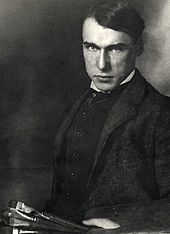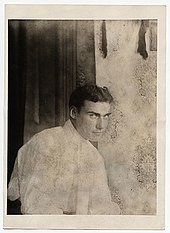Walt Kuhn
Walt Kuhn (born October 27, 1877 in Brooklyn , New York , † July 13, 1949 in White Plains , New York ; actually Walter Francis Kuhn ) was an American painter , cartoonist and lithographer . He was one of the organizers of the epoch-making Armory Show of 1913.
Life
William Francis Kuhn, who was renamed Walter shortly after his birth , was the son of Francis Kuhn, a ship chandler and hotelier, and Amelia Hergehan. The mother was of Spanish descent. It introduced the boy to the fine arts at an early age and established Walt's lifelong interest in painting and the theater . At the age of 15 he sold his first drawings , which he signed “Walt” , to a magazine. In 1893 he took evening classes at the Brooklyn Polytechnic Institute , but initially lost interest in a career as an artist and eventually set up a bicycle shop in Brooklyn with moderate success.
In 1899 he traveled to California with cash of around US $ 60 to get to know the American West . In San Francisco he found a job as an illustrator for WASP magazine . In 1901 Kuhn moved to Paris , where he enrolled at the Académie Colarossi . He then went to Munich to study with Heinrich von Zügel at the art academy . In 1903 he returned to New York, where he joined the young artist scene. For a living, he continued to work as an illustrator for local magazines, and worked with the Kit Kat Club and Salmagundi Club to raise funds for grants from the National Academy of Design .
In 1905 Kuhn had his first exhibition in the Salmagundi Club , in the same year the Life magazine published his drawings. Kuhn spent the summer months in Fort Lee , New Jersey , an early stronghold of the emerging film industry. The film metropolis attracted numerous creative people, and so the New York School of Art (later Parsons The New School for Design ) also settled there.
In 1908 Kuhn became a member of the art school's faculty. But Kuhn was reluctant to teach, he left school and returned to New York. There he met Vera Spier, who became his wife. The two had a daughter, Brenda. In 1909, Kuhn was preparing for his first solo exhibition at New York's Madison Gallery . The show was a great success. In 1911, together with the artists Jerome Myers, Elmer MacRae and the gallery owner Henry Fitch Taylor, he founded the Association of American Painters and Sculptors , which was to form a counterpoint to the conservative academic National Academy of Design . The concept of the Armory Show , as an epoch-making, revolutionary art exhibition, which was supposed to bring European modernism to the USA and establish an independent American modernity in art, finally resulted from the association . Kuhn acted as "executive secretary" who was responsible for the search and selection of artists. The Armory Show , which led to an art scandal that was as tangible as it was to a renewal of US art, which had hitherto been academically influenced, was to become Kuhn's magnum opus . After the exhibition, Kuhn emerged as an advocate for young progressive artists. In 1938, in his essay The Story of the Armory Story , he was supposed to reflect on the groundbreaking art event from the perspective of an “insider”. In 1917 Kuhn founded another artists' association, the Penguin Club , which pursued goals similar to those of his earlier projects.
In 1925, Kuhn fell ill with a duodenal ulcer that almost cost him his life. After a long recovery hiatus, he eventually joined the faculty of the Art Students League of New York . He worked as an artistic advisor for the Union Pacific Railroad . In 1939, near the end of his artistic career, Kuhn organized his first retrospective and published the book Fifty Paintings by Walt Kuhn . Kuhn's eccentricities for which he was known at a young age, began at the age to accept strange forms: Whenever the Ringling Bros. and Barnum & Bailey Circus of PT Barnum toured the city, he joined the showmen on. Since he was behaving more and more conspicuously, he was finally admitted to an institution in 1948 after a nervous breakdown . Kuhn's last years are obscure and unexplained. Rumor has it that he committed suicide, but according to the official version, he died on July 13, 1949 of a perforated ulcer .
Work and meaning
Walt Kuhn is best known as an advocate for the burgeoning New York art world and as the primary organizer of the Armory Show . His painterly oeuvre is less well known, however, and he destroyed many of his early works himself. He was a virtuoso cartoonist, illustrator and painter who expressed his lifelong fascination for theatrical circus themes in paintings such as White Clown from 1929 or Roberto from 1946. Frequently recurring subjects are portraits of clowns with a disturbing effect, reminiscent of the Commedia dell'arte paintings of earlier centuries, as well as artists, drum majors or expressionless vaudeville dancers with brightly colored plumes. At times, Kuhn also painted cubist still lifes.
Exhibitions (selection)
- 1908: Boston Art Club
- 1908-12: Pennsylvania Academy of Fine Arts
- 1911: Madison Gallery
- 1913: Armory Show, New York
- 1914–15: Montross Gallery
- 1921: Pennsylvania Academy of Fine Arts
- 1923/1924: Salons of America
- 1927: Grand Central Galleries, NY
- 1928: Beaux Arts Gallery, San Francisco
- 1930: San Francisco Art Association
- 1930–41: Marie Harriman Gallery
- 1932–48: Whitney Museum of American Art
- 1943-45: Durand-Ruel Galleries
- 1945–49: Corcoran Gallery Biennials
- 1945–49: Pennsylvania Academy of Fine Arts
- 1947: Colorado Springs Fine Arts Center
- 1948: Durand-Ruel Galleries
- 1960: Cincinnati Art Museum
- 1964, 1978: Amon Carter Museum , Fort Worth
- 1966: Maynard Walker Gallery, NY
- 1966: University of Arizona Art Gallery, Tucson
- 1967-68, 1972, 1977, 1980: Kennedy Galleries, NY
- 1984: Barridoff Galleries, Portland
- 1987: Whitney Museum of American Art
- 1987: Salander O'Reilly Galleries Inc., NY
- 1989: Maine University Art Museum
literature
- Philip Rhys Adams: Walt Kuhn, Painter: His Life and Work . Ohio State University Press, 1986, ISBN 0-8142-0258-6
Web links
- Walt Kuhn at artnet.de
- Walt Kuhn at artfacts.net
- Walt Kuhn - biography, exhibition and work directory (English)
- Forum Gallery: Walt Kuhn Biography (English)
- Smithsonian Archives of American Art: Walt Kuhn, Kuhn Family Papers, and Armory Show records (English)
Individual evidence
- ↑ Walt Kuhn Biography. Forum Gallery, archived from the original on February 16, 2006 ; Retrieved August 9, 2008 .
- ↑ a b c Walt Kuhn - American Modernist. Sullivan Goss Gallery, accessed August 9, 2008 .
| personal data | |
|---|---|
| SURNAME | Kuhn, Walt |
| ALTERNATIVE NAMES | Kuhn, Walter Francis (real name) |
| BRIEF DESCRIPTION | American painter, cartoonist, and lithographer |
| DATE OF BIRTH | October 27, 1877 |
| PLACE OF BIRTH | Brooklyn , New York |
| DATE OF DEATH | July 13, 1949 |
| Place of death | White Plains , New York |





